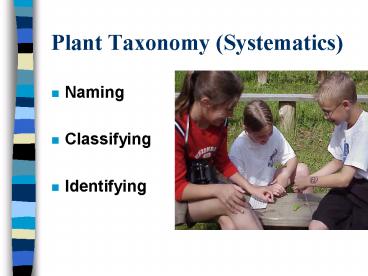Plant Taxonomy (Systematics) - PowerPoint PPT Presentation
1 / 33
Title:
Plant Taxonomy (Systematics)
Description:
A series of paired choices that leads to the correct name of ... internal structures, embryology, DNA, proteins. Analogy. based on superficial characteristics ... – PowerPoint PPT presentation
Number of Views:1425
Avg rating:3.0/5.0
Title: Plant Taxonomy (Systematics)
1
Plant Taxonomy (Systematics)
- Naming
- Classifying
- Identifying
2
Plant Systematics
- Naming
- give an organism a precise scientific name
- Homo sapiens L.
- ICZN, ICBN, ICMN
3
Plant Systematics
- Classifying
- organize into groups
- Primata
- Hominidae
- Homo sapiens
4
Plant Systematics
- Identifying
- finding the name of an organism that has already
been named and classified
5
Dichotomous Keys
- A series of paired choices that leads to the
correct name of an organism
6
Collecting, Preparing and Preserving Plants
7
Collecting, Preparing and Preserving Plants
8
Polynomial Nomenclature
- Ranunculus calycibus, retroflexus, pedulculis
falcatis, caule erecto, folis comopositis
9
Polynomial Nomenclature
- Ranunculus calycibus, retroflexus, pedulculis
falcatis, caule erecto, folis comopositis - The buttercup with bent-back sepals, curved
flower stalks, erect stems and compound leaves - descriptive, precise
10
Binomial Nomenclature
- - Began 1753, Species Plantarum
- Carolus Linnaeus 18thC Sweden
- Ranunculus calycibus
- Genus species
11
Binomial Nomenclature
- - Began 1753, Species Plantarum
- Carolus linnaeus 18thC Sweden
- Genus species
- same species name
- Cercis canadensis L.
- Solidago canadensis L. Authority
- Rules International Code of Botanical
Nomenclature (ICBN) - ICZN, ICMN
12
ICBN Rules
- Genus treated a noun species as adjective
- suffixes usually agree in gender
- Male female neuter
- us a um
- is is
re - er ris
- o
- Lactuca hirsut_
- Lathyrus hirsut_
- Vaccinium hirsut_
13
Binomials
- Often describe some feature
- Incorporate the name of a person or place
- perpetuate a classical name
14
(No Transcript)
15
Binomials
- Quercus alba white oak
- Quercus macrocarpa burr oak
- All tree genera are treated as female!
- Veronica noveboracensis (L.) Michx.
- CHANGE OF CLASSIFICATION
16
Linnaeus Kingdoms
17
Kingdoms
18
Domains
19
Species
- A distinct types of organism capable of breeding
with other members of its own kind - but not with
other species. - Basic category in biological nomenclature
20
Varieties (subspecies)
- Sargent
- Quercus alba L. var. alba
- Quercus alba L. var. latiloba Sarg.
- If Q. latiloba was a new species?
- Quercus latiloba Sarg.
21
hybridization
- Q. velutina X Q. rubra X Q. palustris
- Echinacea pallida
- Echinacea paradoxa
- Echinacea pallida X paradoxa
22
Relationship between Genus and Species
- Genus - a group of related species
- Quercus (oaks) Carya (hickories)
- rubra - ovata
- velutina - cordiformes
- alba
23
Related
- 1. Have similar characteristics (may hybridize)
- 2. Have a common ancestor back in evolutionary
time - velutina rubra alba
24
Related
- 1. Have similar characteristics (may hybridize)
- 2. Have a common ancestor back in evolutionary
time - ovata cordiformes
25
Evolution (implied by classification)
- Organisms that are placed in the same genus are
believed to be more closely related than
organisms from other genera.
26
Phylogenetic Hierarchy
- Kingdom
- Division (Phylum)
- Class
- Order
- Family
- Genus
- species
27
Natural System
- Our present system attempts to group organisms in
accordance with natural (evolutionary)
relationships. - Homology
28
(No Transcript)
29
Natural System
- Our present system attempts to group organisms in
accordance with natural (evolutionary)
relationships. - Homology
- internal structures, embryology, DNA, proteins
- Analogy
- based on superficial characteristics
- outward form and function
30
Standard Endings (ICBN)
- Division phyta
- Class opsida
- Order ales
- family aceae
- Genus
- species
31
Taxa
- Division Anthophyta Coniferophyta Pterophyta
- flowering pines,spruces,
ferns plants firs
- Magnoliopsida
- Liliopsida
32
Classes of Flowering Plants
- Magnoliopsida
- dicots - 2 embryonic leaves
- taproot
- branching leaf veins
- flower parts2s, 4s, 5s
- Liliopsida
- monocots - 1 embryonic leaf
- adventitious roots, branching
- parallel leaf veins
- flower parts 3s
33
Classification of Burr Oak
- Kingdom Plantae
- Division Anthophyta
- Class Magnoliopsida
- Order Fagales
- family Fagaceae
- Genus Quercus
- species macrocarpa
- binomial Quercus macrocarpa

